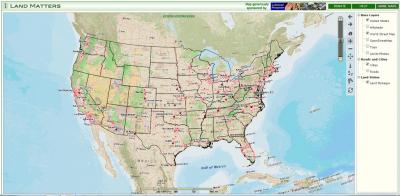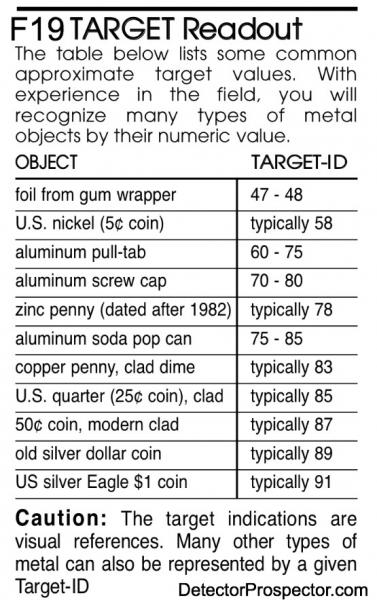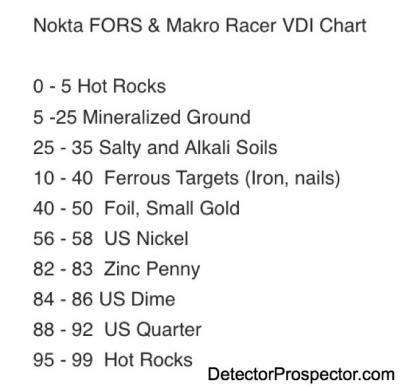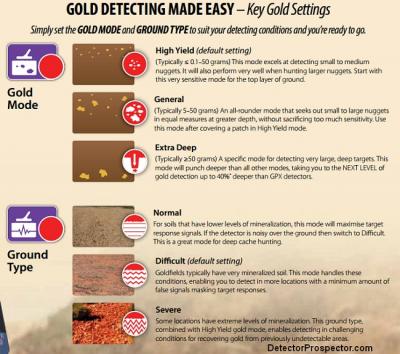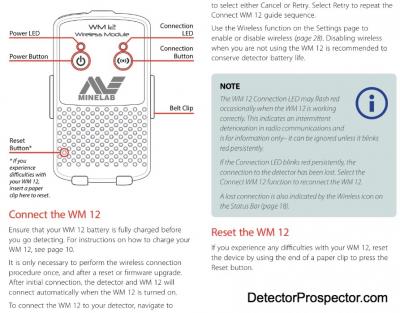-
Posts
19,759 -
Joined
Content Type
Forums
Detector Prospector Home
Detector Database
Downloads
Everything posted by Steve Herschbach
-
A more realistic comment from me would be to once again hope that Garrett will put the ATX into a dedicated dry land prospecting box weighing under 4 pounds and selling out the door for under $2000. Minelab could do exactly the same thing with the SDC 2300 but I will not hold my breath for that. Garrett not doing it though is just crazy in my opinion.
-
When Chris Ralph and I were down in Phoenix I was fortunate that Chris lined up a dinner with Barry and Leigh, the brilliant couple behind the new non-profit educational organization, Land Matters. The website at http://www.mylandmatters.org/ is your constantly expanding source of land related information, including: Library - A Library full of free maps, guides, books, tutorials and reference materials. Maps - Interactive maps for your area of interest. More being added every week. Articles - Factual articles written by those in the know. Information that you can rely on. Resources - Links and contacts to other communities of knowledge. Outreach - Programs that engage the community directly. Seminars, outings, trainings etc. I am far from done checking it all out myself, but this looks like something we should all consider getting on board with and supporting if possible. Check it out. I have added this banner to the rotating collection in the upper left corner: and added them to my links list Barry and Leigh, very nice meeting you, and keep up the great work! Here is a link to the new interactive land management status map http://www.mylandmatters.org/Maps/Management/GetMap
-

Five Rp Bits With Some New Settings
Steve Herschbach replied to jasong's topic in Detector Prospector Forum
Dang, that is some nice, fat gold! Like a lot a people I do like finding trophy nuggets but reality is I would rather have bucketful of nuggets like those any time. Thanks Flak - interactive bounce off each other education for all is the way I look at it. Toss ideas and thoughts out and see what sticks. This forum is the best learning resource I have. -

GPZ 7000 Scores 4 in The One Hole *Update*
Steve Herschbach replied to aussiedigger's topic in Detector Prospector Forum
Rick, it is a scuff cover repair - thread here http://www.detectorprospector.com/forum/topic/801-i-was-told-once-scuff-cover-repair/ -
All right Rick - way to go! Great detector the SDC 2300, the more you use it the more you will like it.
-

Free KMZ / KML Overlays For Google Earth
Steve Herschbach replied to Bullit's topic in Detector Prospector Forum
The same website has a good explanation at http://apeoid.com/how-to-use-kmz-kml-google-earth-protected-areas-files/ Google Earth can be a powerful tool in many ways. Lots of people use it just as a way to get aerial views of locations from the comfort of home. However, kmz/kml files allow vast amounts of information to be downloaded from many sources and layered over Google Earth views. These can be something as simple as saved GPS coordinates and tracks all the way up to very sophisticated map layers. For instance, a geological map or a claims map can be downloaded as a kmz/kml file and loaded into Google Earth. It is one of the most powerful and generally free prospecting tools currently available. Here are State Geologic Maps from USGS in KML/KMZ format http://mrdata.usgs.gov/geology/state/ Active Mines in the U.S. from the USGS http://mrdata.usgs.gov/mineplant/ KML Geology: Using Google in Geology. A site by San Diego State University with mostly California related KML files and other KML resource information Converting Shapefiles (and more) to KML Some Australian Resources -

New Nokta Dealer in the USA!
Steve Herschbach replied to Nokta Detectors's topic in Nokta / Makro Metal Detectors
I will have to tell Chris he has the pictures for the FORS CoRe and FORS Gold packages backwards! AZO is a good outfit, good to see options. -
Ho, ho, you got me there Dave. In automatic tracking since it is always ground balancing it is inevitable you will be ground balancing over a target. And I did just say never do that! It may very well prove that a person in some places where the ground mineralization does not vary much that you should run the GPZ in fixed. I always ran my GPX in fixed, and every VLF I use normally the automatic ground tracking stays switched off. JP says there is concern that the GPZ tracking can balance out faint targets and that he has made the programmable "User" button the ground balance setting, just do he can temporarily turn the ground tracking off. That seems to argue to me that I much of the ground I detect in, that maybe just leaving the tracking off is a better idea? I honestly do not know for sure. I admit some things when I get a new detector, I just go with a bit on faith. It appears to me that extreme care has gone into making the GPZ ground tracking very sophisticated and reliable. I immediately just started using it constantly and so far have not had any reason at all to regret doing so. Maybe with more use and more consistent attention on my part I will decide otherwise. I got a pretty good start at getting good with the GPZ but everything pretty much came to a halt in December and I have minimal time using it the last three months. Now, I will be using it nearly every day in the very near future. Hopefully I can complete my journey of learning most everything there is to know about the GPZ 7000. I am certain things I am doing now or believe to be true may be modified or even reversed with more use. That is part if the fun, having an open mind and learning new things. Right now I am pretty darn excited. I am going to go find a bunch of gold this summer! I am letting the GPZ tell me how it likes to be used instead of trying to tell it how I want it to work. So far that has been working real well for me.
-

Zed Scores Big On Civil War Relics
Steve Herschbach replied to karathound's topic in Metal Detecting For Coins & Relics
Figure 2 shows a comparison between the ZVT VRM soil signal and the nearest equivalent PI soil VRM signal; both transmitted magnetic signals being bi‐polar, with the same fundamental frequency and same rapid change of magnetic field period. It should be noted that the PI receive period is half that of the ZVT period, because the PI system shown in figure 2 transmits for half the time and receives for the other half of the time, unlike ZVT that transmits and receives simultaneously just about all of the time. The important difference in the VRM signals is that the PI signal decays away substantially faster than the ZVT system. This indicates that the receive signal for PI is less sensitive to longer Time Constant (TC) components compared to shorter TC targets than ZVT, and this is one of the main reasons why ZVT technology is better at detecting large nuggets compared to PI; another main reason being from the double length receive period in ZVT compared to PI for the same fundamental frequency. -

Target VDI Lumping?
Steve Herschbach replied to goldbrick's topic in Metal Detector Advice & Comparisons
I find it very hard to choose between the F19, Racer, and FORS CoRe. They are very close in performance. For those liking a long reach or the use of large coils, the FORS is better balanced. Racer is slightly nose heavy and F19 more so, making them better for short rods and small coils. Interesting Australian opinion on F19 vs Racer in really bad ground https://www.prospectingaustralia.com.au/forum/viewtopic.php?id=11147 I am still holding out for the Gold Racer but do not know how long it will be. I will be using Racer and FORS and F75 until it appears, by which time I am also hoping the black and gold F19 will finally appear. I guess I will finally sort it all out by winter. I will probably have another detector clearance sale before the end of the year. More information on the new Makro Racer -

Target VDI Lumping?
Steve Herschbach replied to goldbrick's topic in Metal Detector Advice & Comparisons
The target id range for the Teknetics T2, Gold Bug Pro, F19, FORS Gold & CoRe and Gold Racer are nearly the same, with non-ferrous ranging from 40 to 99. High frequency detectors have more VDI spread on the low conductive end and compress more on the high end. Low frequency detectors just the opposite. The low conductors tend to be closer together, and more target resolution on the high end. http://www.detectorprospector.com/forum/topic/532-nokta-fors-and-makro-racer-vdi-chart/ http://www.detectorprospector.com/forum/topic/526-fors-gold-f75-v3i-tone-and-vdi-tidbits/ "Native" target VDI ranges can be "normalized". You are probably familiar with the fact that the DEUS VDI numbers change depending on the frequency you select. 18 kHz compresses high end numbers as described and in fact appears worse than some with most coins lumped in the 90s range http://metaldetectingforum.com/showpost.php?p=1428436&postcount=7. I believe the latest version of the software offers the ability to normalize VDI numbers across frequency choices? The White's V3i lets you pick any one of three frequencies. You can run each frequency with its native VDI range, or chose to normalize the VDI numbers. Normalize means make them all the same, regardless of frequency. Usually they will be normalized to a middle frequency, in the case of the V3i it is 7.5 kHz. So, if you really care about whether it is a penny or a dime or a quarter or a half dollar, running a detector in a low frequency is better, especially with native VDI numbers, as you get more target spread (less lumping) in the coin range. Conversely, for jewelry detecting running high frequency native VDI numbers gets you more spread in the gold/lead/aluminum range. Bottom line, the Gold Bug Pro, F19, FORS Gold & CoRe, and Racer all lump copper pennies, dimes, and quarters into the same fairly tight range. Wouldn't you just dig them all anyway? You want adjustable VDI spreads nothing beats a White's V3i. -

Zed Scores Big On Civil War Relics
Steve Herschbach replied to karathound's topic in Metal Detecting For Coins & Relics
I would not expect General to outperform High Yield on air tests myself. That is sort of like air testing a high frequency Gold Bug 2 against a lower frequency detector. The Gold Bug 2 wins the air test and loses the in ground test. It is the performance in ground relative to the ground mineralization that makes all the difference in the world. -

Zed Scores Big On Civil War Relics
Steve Herschbach replied to karathound's topic in Metal Detecting For Coins & Relics
Reading the Aussie forums again? High Yield is the loose equivalent of a short pulse delay timing. Very hot. General would be a longer delay type setting, less hot on tiny stuff but allows for clearer signals on medium gold. Extra Deep would be the equivalent of a long pulse delay setting only for very large targets but gives up a lot on the smaller stuff. Not a good mode for general gold prospecting, but may be good for dialing down the sensitivity for small surface trash and so useful in really trashy locations or for relic hunting. Or for looking for that really big deep nugget people are convinced they are going to find. 50 grams may as well say a couple ounces. If you are hunting 2 oz plus nuggets this is the mode to go with in theory. I doubt Minelab made it up as a marketing ploy. If they say it will punch deeper than the other modes, it probably will. But only on massive targets. Extra Deep may or may not give up depth on those big bullets. Even a bit of lost depth may be ok if tiny surface stuff can be ignored. Definitely a setting I will be experimenting with more. -

Zed Scores Big On Civil War Relics
Steve Herschbach replied to karathound's topic in Metal Detecting For Coins & Relics
Hi Bob, Not off topic at all, as it says in the forum header "A forum dedicated to prospecting for gold and other precious items using metal detectors, suction dredges, sluice boxes, gold pans, and more. Metal detecting for coins, jewelry, relics, meteorites, etc." I am vitally interested in your links because there is a huge overlap in what relic hunters in very mineralized ground are doing and what prospectors are doing. It is all about max depth in bad ground, and relic hunters back east have discovered what prospectors have known for a long time - nothing can match a good pulse induction for depth. Until now with the new GPZ. I knew the GPZ had the power, but what I have been wondering about is the issue with it being so hot on small stuff. This is generally good for prospectors, but I thought maybe it would be a real problem for the relic hunters and tiny surface trash. I wonder if the Extra Deep mode might ignore that small surface trash while still punching deep on those bullets, etc. It looks like the GPZ once again proves it packs the punch. If people can deal with the trash issue it may be the next big thing in relic hunting, especially at DIV. The bottom line is that wherever good finds exist somebody is eventually going to put a GPZ on it, even if it means digging all the junk. Thanks for posting as I will be following it all with interest. -

GPX Help For A Beginner Please?
Steve Herschbach replied to Rege-PA's topic in Minelab Metal Detectors
Going after trashy for those with the fortitude to slowly get it out of the way is a good strategy, provided of course that there is a decent chance gold is lurking. People with PI detectors tend to avoid trashy sites, yet mining camps were often built on the richest ground. You are in the right area for sure, just have to be persistent and keep at it. It took me years to find my first gold nugget with a detector, but once the first one happens, it is like a dam breaking loose. Many, many people report a similar experience. That first one is the hardest for all but the very few. Good luck!! a few more tips.... Steve's Guide to Metal Detecting For Gold Nuggets -

Big Nuggets - Do You Really Need A GPZ?
Steve Herschbach posted a topic in Detector Prospector Forum
There has been another big nugget find in Australia - by an 81 year old grandmother! 18.85 ounces. http://www.9news.com.au/national/2015/03/25/07/16/victorian-grandma-finds-gold-nugget There was the 87 oz find recently http://www.detectorprospector.com/forum/topic/711-87-ounce-gold-nugget-found-in-victoria-australia/ And the 6 pound nugget from California http://www.detectorprospector.com/forum/topic/367-monster-multi-pounder-nugget-found-in-northern-california/ Every one of these large nuggets could have been found with just about any decent metal detector made. They were all quite shallow. The largest nugget ever found with a metal detector, the Hand of Faith, was found decades ago with a VLF. In fact, most all of the largest nuggets found with metal detectors were found decades ago with VLF detectors. This reveals a basic reality. Yes, there are large nuggets at depth, but for various reasons in desert terrain the largest gold is often found very shallow. In the 1800s when they found new gold locations nuggets were literally just sitting around waiting to be picked up. So while it is true new technology is producing more gold at depth, when it comes to chasing those really big monster nuggets, a surprising number being found even today are simply ones that have been missed by everyone up until now. To find one, you do not need a super detector, you need to put your coil over ground that has not yet ever seen a coil. Those expecting lots of large nuggets to appear from ground pounded by others for decades just because a new detector gets a few more inches are likely to be disappointed. It is going to happen, just not near as often as people expect. -

Kellyco Monopoly on Nokta Busted?
Steve Herschbach replied to goldbrick's topic in Nokta / Makro Metal Detectors
Maybe Rob can get Nokta now? I encouraged him to get Makro because Kellyco had Nokta locked up and also because of the upcoming Makro Gold Racer. -

GPX Help For A Beginner Please?
Steve Herschbach replied to Rege-PA's topic in Minelab Metal Detectors
Hello Mathew, Welcome to the forum! Sounds like as far as the detector goes you have it figured out. It is simply a metal detector and you have it detecting metal. Bullets and lead are the best indicator of your detecting skill. The smaller the bullets you find and the deeper they are, then the better you are doing. Lead and gold read approximately the same. Now you just need to put the detector coil over some gold. Buying a detector is easy, getting it to work is actually pretty easy. Getting the coil over detectable gold - not so easy. Like buying real estate it is all about location, and that knowledge is gained through research. The easiest solution for beginners is to go where gold has already been found. Most any decent gold location will usually give up at least one more gold nugget if hunted patiently. In order to do more than find just a few nuggets you have to get off the beaten path and explore hard to reach locations. This involves more research and a willingness to take risks in the form of time spent detecting places where good has not been found before by many others. Learning as much about gold geology as possible, including reading geologic maps, is very key to success. Bottom line? Metal detecting is easy. Prospecting is not. Most people can become reasonably good with a detector. Becoming a good prospector is a totally different thing in that what you are learning is where and how to place yourself over shallow detectable gold. In the U.S. I usually recommend joining a club to meet others whole may be able to act as guides and mentors. I am not sure if the equivalent resource exists in Australia? Gold Fossicking Australia http://www.gold-net.com.au/fossicking1.html Gold Prospecting U.S. http://geology.com/articles/gold-prospecting-tools/ Patch Hunting http://www.minelab.com/emea/treasure-talk/so-you-want-to-find-a-patch -

Kellyco Monopoly on Nokta Busted?
Steve Herschbach replied to goldbrick's topic in Nokta / Makro Metal Detectors
Very interesting. More choices in suppliers is always better! -

Five Rp Bits With Some New Settings
Steve Herschbach replied to jasong's topic in Detector Prospector Forum
Good job on the gold and great photos - thanks! Bummer about the pick though. Been there, done that. The WM 12 is line of sight. Mine perched on my left shoulder cuts out a smidgeon now and then. But nothing like you describe. Do a reset and re-pair it with the GPZ. Should solve the problem hopefully. -
The postage thing works different ways different places apparently. When my CTX 3030 had to go back to Minelab U.S.A. for a GPS fix they paid postage both ways. Best thing is if you buy from a dealer - just take it back to the dealer. Not sure what was up with the situation as reported in Oz but if it were me I would be raising a fuss. It can be worse and is not as out of the ordinary as you may think. I was the largest Ski-Doo snowmobile dealer in North America, based in Alaska. If you lived in middle of nowhere Alaska it might cost $1000 just to have the snowmobile air freighted out to you. Now after 100 hours to motor blows up under warranty. The warranty states must return item to nearest warranty center at your expense. Why? Ski-Doo did not make you live in the middle of nowhere. Your choice, along with the consequences. So you have to pay to ship the machine airfreight back to town to get your warranty work done, then pay again to get it shipped back out. Huge freight bills. And this was not just Ski-Doo, it was most anything and just life in Alaska. I conjecture the warranty for Minelab in Oz says return to warranty center for repairs. If that means a short drive or shipping across the continent it could cost. Not excusing it or anything mind you, but do read warranties for big ticket items before making purchases to prevent unpleasant surprises. I am going to go grab my warranty from my GPZ right now, copy it, and post it on a new thread.


